Rewilding India, One Parcel Of Land At A Time
First published in Sanctuary Asia,
Vol. 42
No. 10,
October 2022
Words by Francesca Cotta, Sejal Wohra, Nirmal Kulkarni, Ahmed Chamanwala, and Aditya Dicky Singh
We are now in the Decade of Ecosystem Restoration. Launched in 2021 by the United Nations, it is a rallying call for the large-scale global protection and revival of ecosystems – particularly degraded and destroyed ones. The necessity of ecosystem restoration has been clearly explicated over the decades: it is one of the most effective solutions to the most pressing issues that humanity faces today. The latest IPCC report ranks it as one of the top five measures to reduce greenhouse gas emissions by 2030.
How much do we protect and restore? Based on the most up-to-date scientific research and enduring traditional knowledge, we know that if around half of the ecoregions that house our planet’s biodiversity are protected, we can avoid breaching some of the key planetary boundaries. And so, it is common sense that we respect the sovereignty of nature and leave her at least Half the Earth.
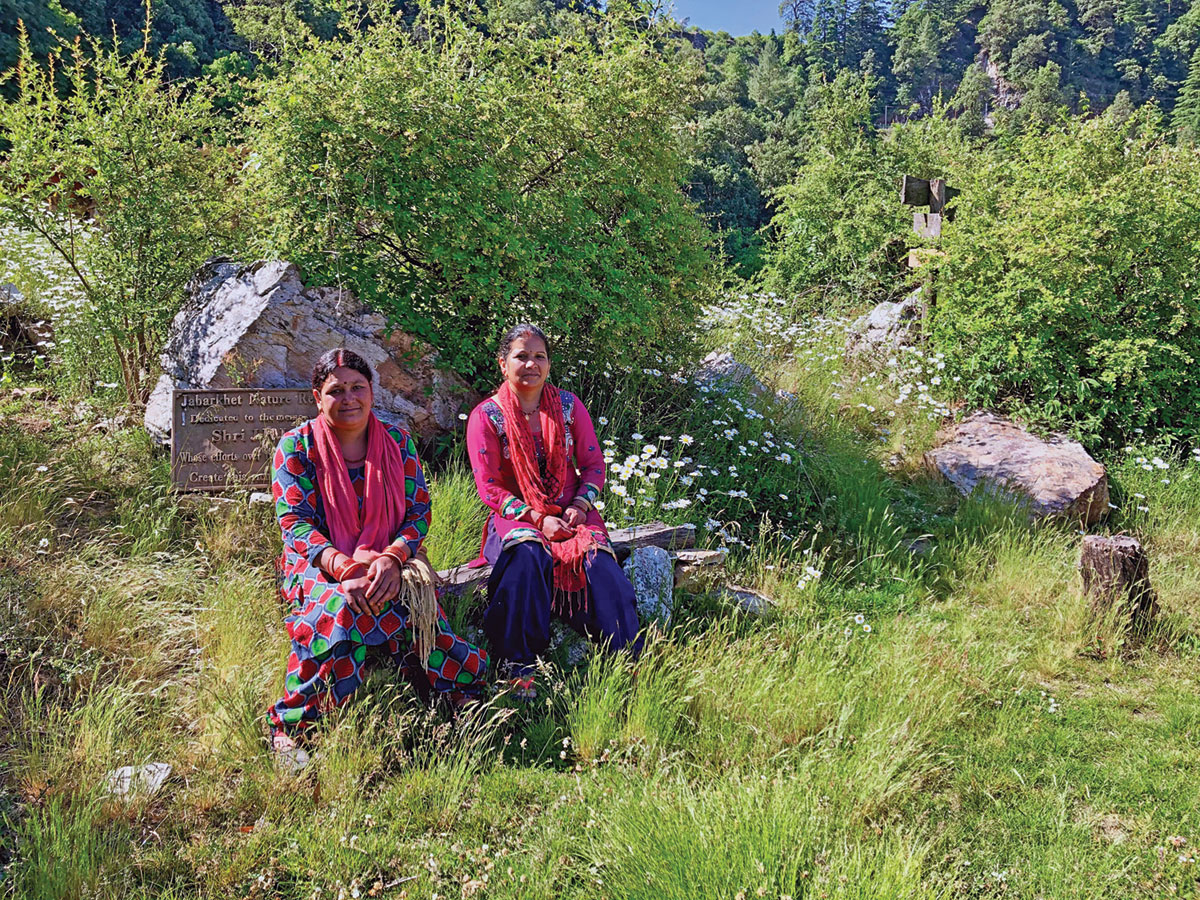
Local employees at the Jabarkhet Nature Reserve. After some initial hesitation, the resident community that lives near the reserve now appreciates what the presence of JNR means to them. The local economy has flourished, both from direct employment and indirect benefits from visitors. Photo Courtesy: Jabarkhet Nature Reserve.
These uplifting and hearteningly sensible visions for our shared future need ambassadors – people whose efforts are locally attuned to the social and ecological realities of where they are.
Though forests form around 20 per cent of India’s landmass, less than five per cent are part of the Protected Area (PA) network. These PAs tend to be relatively small, fragmented (whilst frequently being under threat of further fragmentation on account of developmental pressures), and lonely tracts of land. Forested land surrounding these PAs, often modified for human use, holds immense potential to become wildlife corridors, ancillary habitats for wildlife, and storehouses of local biodiversity. A rewilded parcel of land adjoining a protected forest also increases the availability of forest-based resources to humans and livestock, thus reducing the pressure on Protected Areas, which are supposed to be free of anthropogenic disturbances.
Tourism, when undertaken sustainably, strategically and thoughtfully, presents an economically viable, low-footprint, and high-impact solutions to the urgent need to restore and rewild even larger parcels of land. It is a porous industry, which brings in huge revenue and employs thousands of people. When undertaken in partnership with local governments, NGOs and community members, tourism can become a strong backbone for rewilding initiatives while also hugely benefiting local communities.
Individuals and small organisations who have spent years restoring degraded swathes of land, where they now invite visitors for a different experience, have a lot of valuable insights on both the social and biological aspects of conservation and restoration, and provide a portal to the average citizen into a new story of humanity where rewilding is a way of life and the status quo. We speak to a few such people for our cover story.
Jabarkhet Nature Reserve, Uttarakhand
Located a few kilometres from the hill station of Mussoorie, the 100 acre Jabarkhet Nature Reserve (JNR) is a soothing panacea against the disquietingly polluted and increasingly concretised tourist traps in the area – which, ironically, draws flocks of visitors for its natural beauty.
Over a decade ago, Dr. Sejal Worah, a conservationist and sustainable development expert with 25 years of experience who currently works as the Programme Director at WWF India, returned to her hometown of Mussoorie after several years abroad, and was shocked at the state of the environment, the uncontrolled development, the loss of forest cover, and the general neglect of the area that is today part of JNR. In 2013 she approached the landowner, a Mumbai-based businessman, and convinced him that restoration and rewilding of his land would be a legacy for future generations. He did her one better – he convinced her that if the concept of a private nature reserve was to be successful, it should be a self-sustaining business. Shortly after, they began a joint venture to set up the first private nature reserve in Uttarakhand with the aim of demonstrating the links between conservation, sustainable tourism, and local livelihood development.
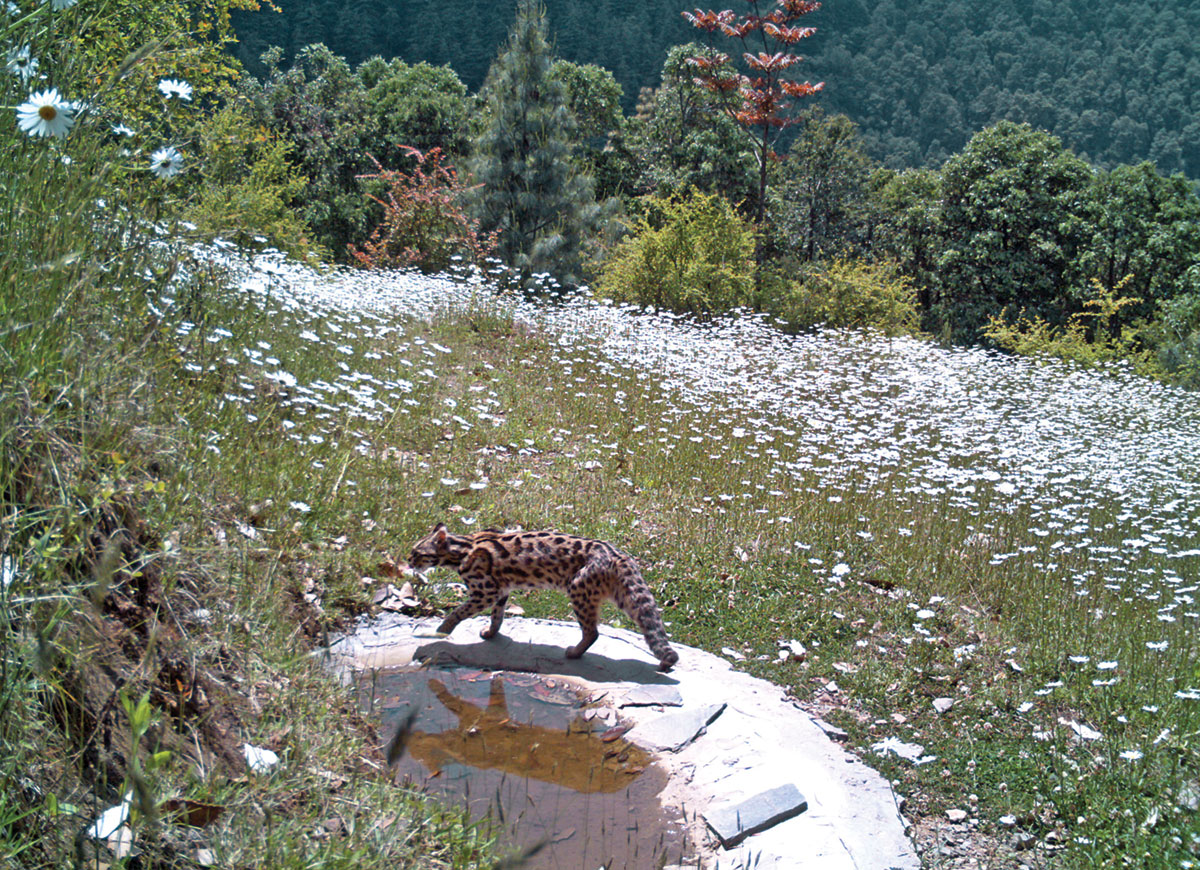
A camera trap image of a leopard cat at a watering hole created by the Jabarkhet Nature Reserve for wildlife. These strategically placed camera traps capture wildlife movement and are shared with visitors in real time. It is exciting for them to see that a leopard used the same trail just an hour before them, or that a pair of martens was playing at the very spot just minutes ago. Photo Courtesy: Jabarkhet Nature Reserve.
The first year brought many learnings for Sejal and her team. They cleared the site of the reserve of hundreds of kilogrammes of garbage, and removed alien and exotic plant species from the forest area. They successfully convinced locals that regulating resource use by curbing activities such as overgrazing, unregulated tree felling and lopping, hunting, and the unchecked collection of other natural resources, was in their best interest in the long run.
With the help of many experts who volunteered their time, camera traps were placed around the area, and surveys of flora and fauna were conducted. The team decided that the most non-intrusive way to generate self-sustaining revenue for the reserve was by promoting guided nature walks. Sejal and her team identified and demarcated walking trails, placed sign boards, and designed trail maps and guidebooks. They also trained a group of local youth to become nature guides to lead the walks. This has proven to be one of the best outcomes of this rewilding project; the youth are passionate, committed, and enthusiastic, and their job earns them a lot of respect among visitors and the local community alike. A number of locals have also been employed in the management and maintenance of the reserve.
Within just a few years of removing anthropogenic pressures and giving the forest a chance to recover, the JNR team have seen the regeneration of ground vegetation; after creating water sources, allowing grasses to recover, not lopping oak trees, and allowing berries and wild fruits to flourish, and have even seen the return of bears – which had not been reported from the area for 40 years. Over time, they have documented the presence of almost all large mammals found in this part of the Himalaya. It is clear that though it is small, the reserve acts as an important refuge and corridor for wildlife.
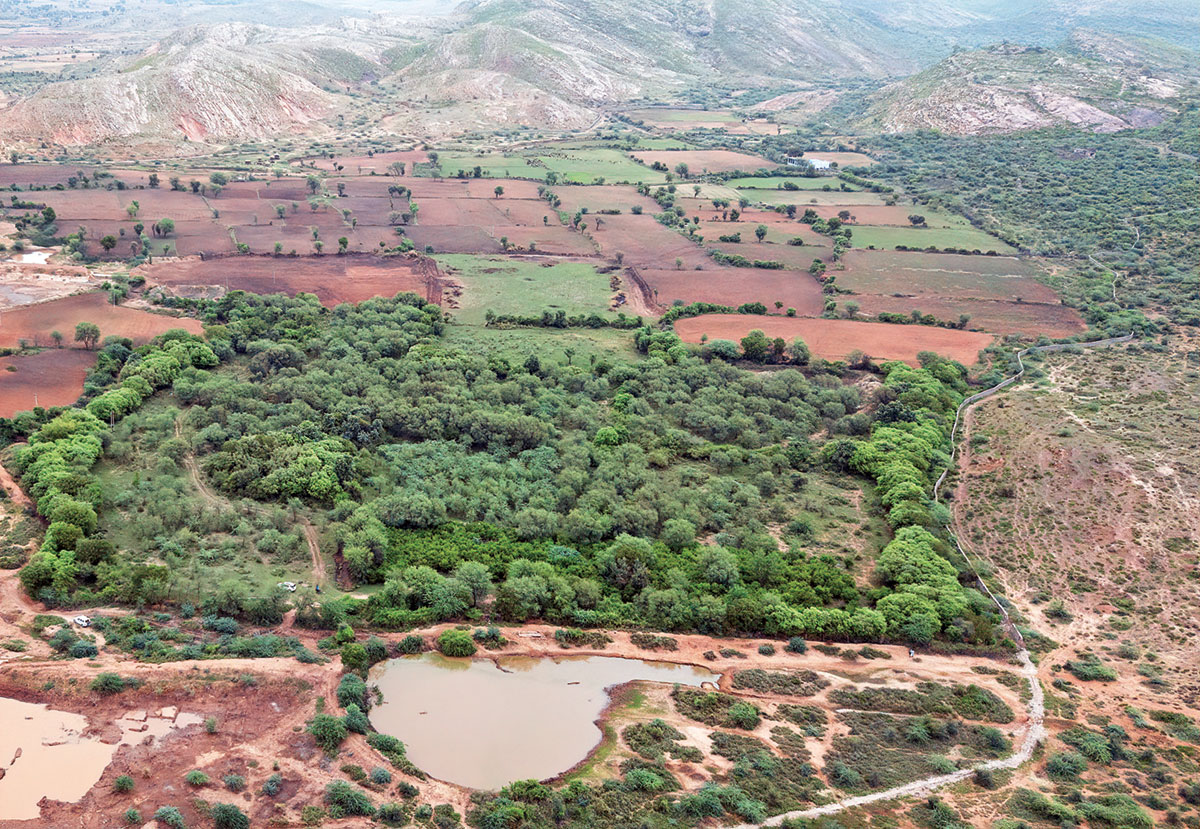
An overhead view of Aditya and Poonam Singhs’ reforested land near the Ranthambhore National Park in Rajasthan. The area was once a degraded forest in an abandoned village that the couple now protects. Photo Courtesy: Aditya Singh.
With the low-key marketing of a limited range of ecotourism products such as themed, guided nature walks and individual and institutional memberships, JNR has managed to become a well-known offbeat tourism destination. They now break even in terms of operating costs, and were even able to generate a small corpus that kept them going through the pandemic.
The local economy has flourished both from direct employment and indirect benefits from visitors. Homestays have cropped up in the area, dhabas have been upgraded to cafes, cloud kitchens have appeared, and taxi drivers benefit from a new destination. They have also involved villages in the area to be part of the venture by developing circuits where visitors trek through and each one is able to offer a meal or a service for a direct income. They also share a percentage of the tourist fee from such walks with the village ecotourism committee.
For visitors, the appeal of this place is that they get to immerse themselves in nature and learn about the wildlife in the Himalaya, not far from the popular town of Mussoorie. The local nature guides take them on a walk that is tailored to the interest and experience of the group. From serious birders and photographers to someone who has never experienced a walk in a forest or a hill climb – all are welcome. They share the camera trap images with visitors in real time. It is exciting for them to see that a leopard used the same trail just an hour ago.
Sejal and her team noticed an increase in hunting and tree cutting during the pandemic when there were no visitors to the reserve for nearly a year. She believes this makes a strong case for well-managed, low footprint tourism to play a role in supporting conservation. In the future, they would like to expand the area rewilded under JNR for increased impact. Sejal looks forward to the day that this beautiful reserve thrives under the management of a local team.
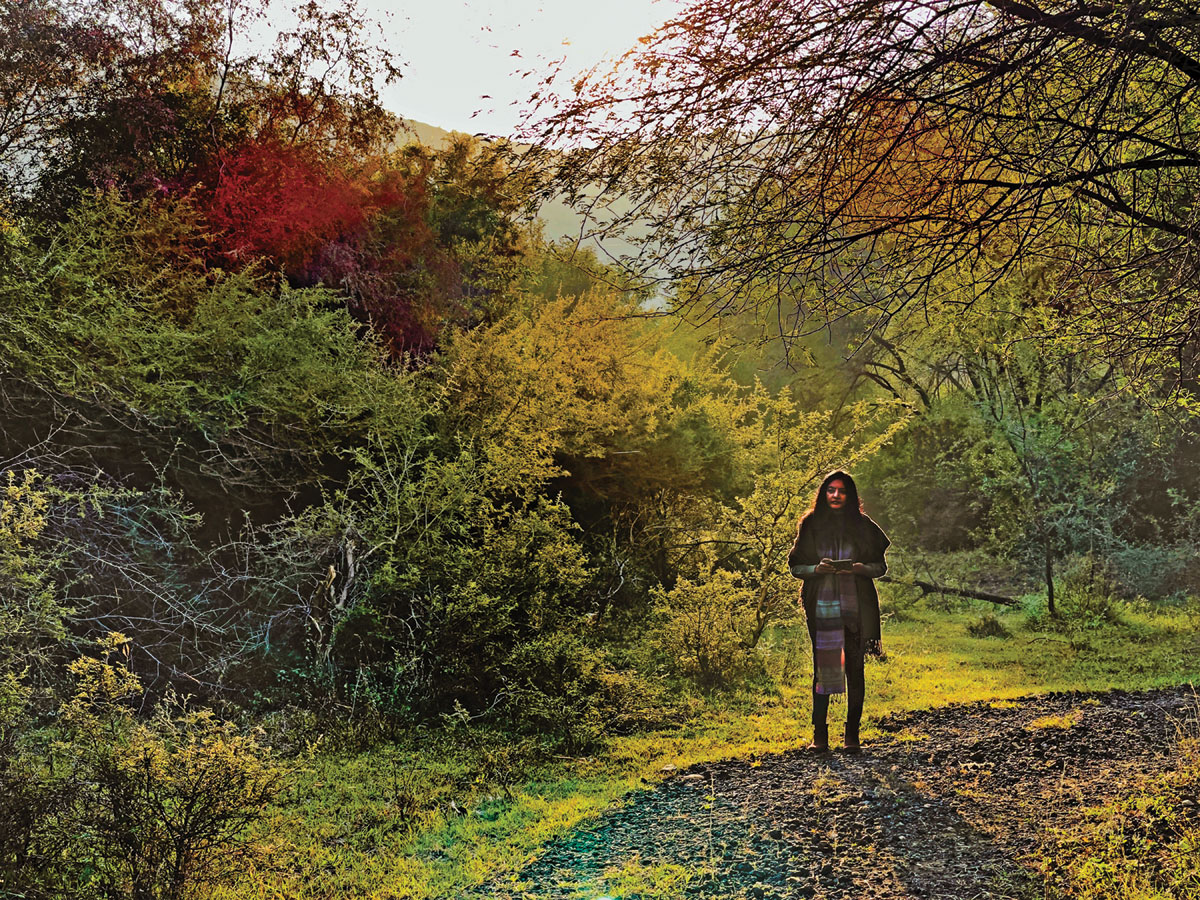
Poonam Singh standing in the heart of the couple’s land. There is a motorable track that the couple has created for a more easily accessible route during the wet season so that jeeps don’t get stuck in the black soil. Photo Courtesy: Aditya Singh.
Badlav, Rajasthan
In 2019, a young male tiger named T-104 killed an old woman at the opening of a ravine in Kundera village, close to Ranthambhore National Park. Shortly after, he was tranquillised, radio-collared, and taken back into the national park by the Forest Department. Some time after this incident, he was again found outside the park, sans radio collar. A stretch of private land bordering the national park, with sufficient forest cover, prey and distance from human settlements, became his refuge during that time.
That land belongs to Aditya Dicky Singh – a wildlife photographer turned conservationist who as our editor, Bittu Sahgal once put it, is a veritable encyclopaedia on all things Ranthambhore – and his wife, artist Poonam Singh. The couple first fell in love with this place in 1998 and from 1999, over 20 years, the couple have bought 35 acres of degraded land once owned by subsistence farmers, that flanked the national park, close to a village called Badlav. Over the last two decades, the couple has been busy fencing the property to protect it from wandering cattle, removing exotic and invasive flora, and allowing the land to restore itself to its original Aravalli landscape. Some well thought out landscaping interventions by the couple have given the land a chance to retain water for long periods of time. Today, the two watering holes in these forests are some of the last available sources of water for wildlife come the summer months. An aerial view of the property reveals an oasis of green, stark against the patches of brown, dry land surrounding it.
With the Ranthambhore Tiger Reserve as this private forest’s ‘seed bank’, the land functions as an outward projection of this Protected Area, acting as a buffer zone between the national park just across their boundary wall and the farmholdings on the other side. Once the native flora came back, this forest has turned into a protective buffer zone for the reserve, often frequented by tigers, particularly during the summer season.
Ranthambhore National Park, where hundreds of species of wild flora and fauna have been recorded, has, over the years, been flourishing as one of India’s most popular tiger destinations. This mushrooming tourism economy presents a tremendous opportunity to develop pastoral and agricultural lands bordering the reserve in a sustainable manner such as that undertaken by the Singhs at their Badlav forest property. A team of guards from the local community was employed to ensure the protection of wildlife here. Besides tigers, leopards, nilgai, sambar, wild pig, small mammals and birds are also routinely found on site.
The funds needed to undertake this rewilding project came from a very successful wildlife lodge called The Ranthambhore Bagh, which Aditya and Poonam ran from 1998 to 2019. With 12 rooms as well as comfortable tents for wildlife enthusiasts and professionals, they would offer a wide range of activities such as hikes, nature walks, safaris, birdwatching, and local village tours. Many of their regular visitors have turned into lifelong friends who would visit a couple of times a year. Therefore, when they closed the lodge in 2019 and began constructing their home on a one acre plot nearby, they made sure to build in five guest rooms so that they can function as a homestay that is open mainly to their longtime regulars.
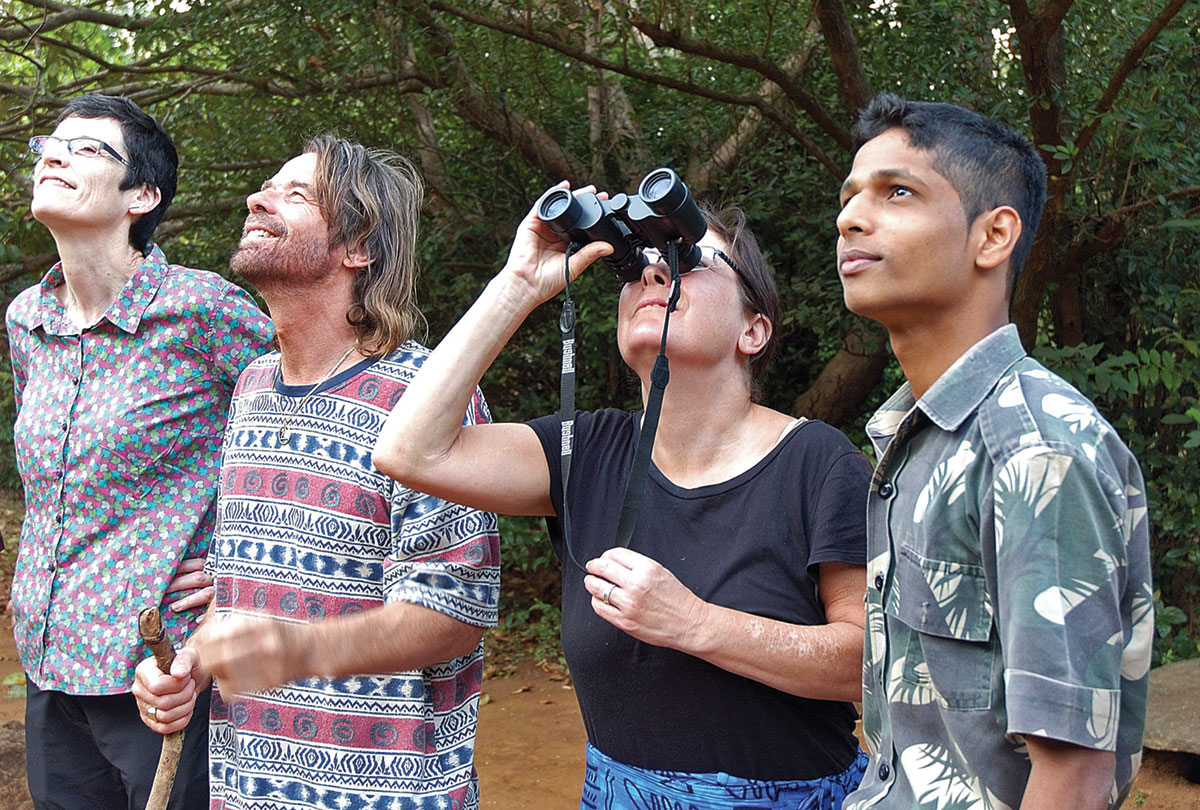
Wildernest’s inhouse naturalist Vitthal is an expert birder and tracker. Here, he is seen helping guests watch birds on the property. Rich in avifauna, ornithologists have catalogued over 220 bird species in the region, including the Great Pied Hornbill, the Imperial Pigeon and the Ceylon Frogmouth. Photo Courtesy: Nirmal Kulkarni.
Wildernest, Goa
Wildernest’s wildly successful two-decade journey is testimony to how, when the end goal uncompromisingly remains protecting forests, supporting local livelihoods, and giving biodiversity ample opportunities to thrive, tourism can become a powerful tool to enable that vision. It demonstrates how spaces, which are constructed in harmonious consonance with their surroundings are likely to provide a far more delightful experience than ‘cookie-cutter’ tourism infrastructure, that is detached from its local, cultural and ecological context.
In the late 1990s, Captain Nitin Dhond came across a parcel of land nestled in the valley of Lasni Temb, the highest peak at Chorla ghat, a vital wildlife corridor in the Western Ghats, which had been badly degraded thanks to resource extraction activities such as timber, mining, and monoculture plantations for cash crops. He put his entire earnings into buying the land over the next few years, and gathered a team of die-hard nature lovers and seasoned ecologists such as Nirmal Kulkarni to envision a collective dream that came to be known as Wildernest.
Their objective was to create a sustainable venture, which would conserve the forest biodiversity of the region and also bring to limelight the natural and cultural wealth of Goa’s Western Ghats. They wanted to create a place where nature conservation would take centre stage, with material comforts matching international standards of hospitality.
From forest officials, village elders and local NGOs to architects and hospitality greats, the Wildernest team was offered unconditional support and guidance when it was most needed, from those that recognised that the project would shape the path for ecotourism in Goa.
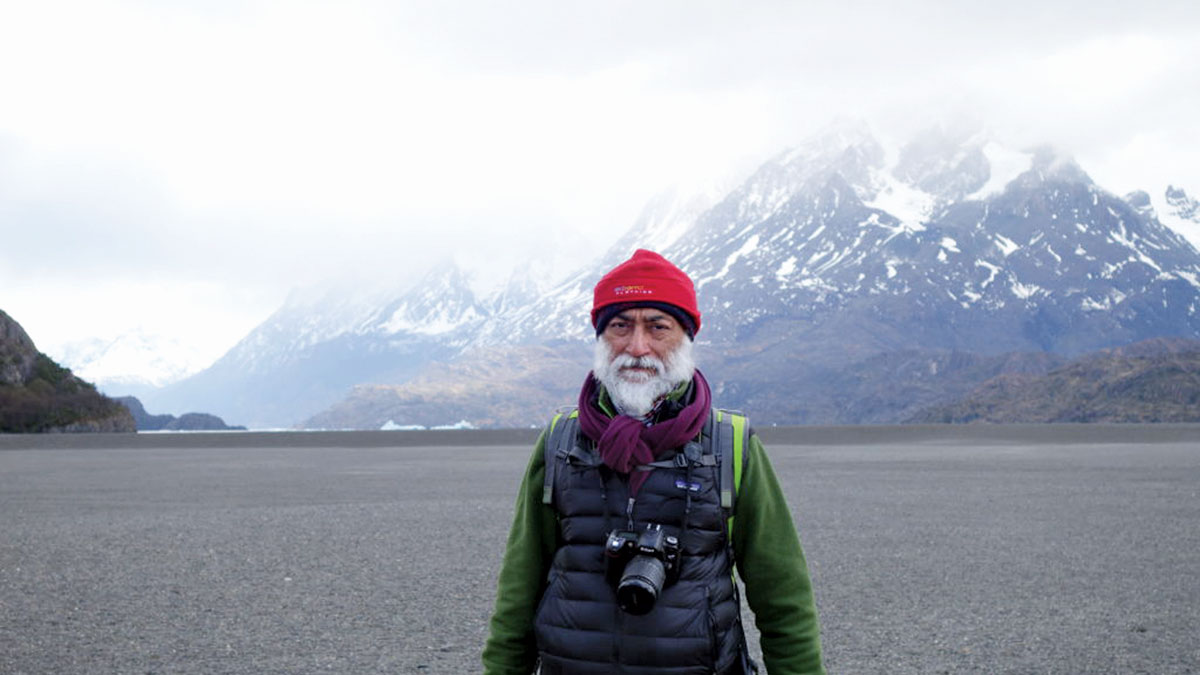
“Responsible Tourism by definition benefits the traveller, the industry, and the destination. More importantly. ... local communities, the true custodians of tourist destinations, must become the direct beneficiaries of the unique experiences only they can offer.”
- Mandip (Mandy) Singh Soin, Founding President, Responsible Tourism Society of India.More than 200 men and women from village communities spanning the states of Goa, Karnataka and Maharashtra, toiled for two years to create Wildernest. They had to first harvest rainwater from a few kilometres away and generate their own electrical power. Social workers and environmentalists guided their founding principles and provided them with field staff for operations. Today, the resort supports 300 families directly or indirectly.
Ecologically, the region is of great importance as it is the catchment area for the tributaries of the Mhadei river – the Haltar nullah and the Valvanti river, among others. The mixed moist deciduous and semi evergreen forests nurture and support a criss-cross network of rivulets and streams that go on to support a vast diversity of life forms, many of which are endemic and threatened in the Western Ghats. A ‘wildlife corridor’ that allows for the free movement of large mammals like tigers, leopards and wild dogs, the Chorla ghats area of the Mhadei region is wedged between the tri-state boundaries of Goa, Karnataka and Maharashtra. This area is ecologically important but rich in minerals too – a dangerous trait for any forest.
Wildernest Nature Resort is based on the sound principle of ‘minimal interference’. The team wanted to create a natural aesthetic and infrastructure that blends well with the location, a task that took years to plan and execute, and two years to construct. Today, with 22 eco-cottages that have lofty views of the surrounding Ghat and the majestic twin Vazra Sakla waterfalls directly in sight, a restaurant serving local cuisine, a beautiful ionized infinity pool that uses minimal chlorine and an Ayurvedic rejuvenation centre, the resort provides an array of experiences including nature walks, treks, village visits and folk dances. Two decades after it started operations, and having declared its 900 acres of forest a private sanctuary called Swapnagandha Valley, Wildernest has not only protected vital forests but has also succeeded in curbing wildlife poaching to a large extent, and saved the catchment area of the Haltar nullah and Valvanti river. In keeping with its ‘minimal interference’ policy, the resort itself takes up only eight acres on this sprawling property.
Wildernest offers an economically viable alternative as a space for nature tourism rather than activities like mining and timber, which ravage forest lands. The project has been at the forefront of promoting social forestry timber like acacia and other recycled wood and materials for infrastructure, a trend that is being emulated across South India now. In addition, they have their own bio-waste plants that create manure, a strict implementation of plastic reduction as well as a recycle and reuse policy.
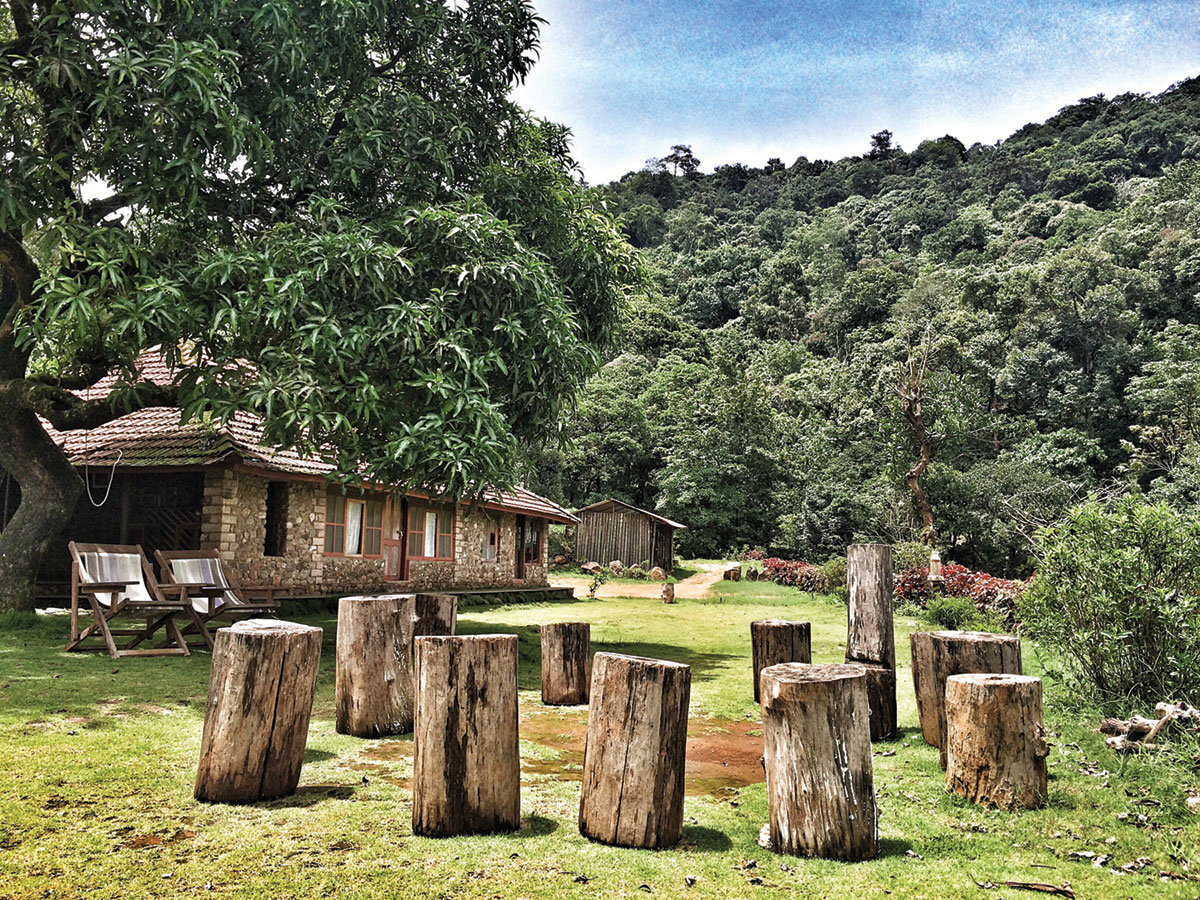
From being a place of undisturbed wilderness prior to 1913, to a century of mismanagement, to a private conservation initiative, Fringe Ford seems to have come full circle. Photo Courtesy: Fringe Ford.
Initiating wildlife documentation and research projects with the help of field biologists and ecologists, they have helped generate vital data on the flora and fauna of the region. Since they began this project, three new species of caecilians have been discovered here besides two species of frogs and a scorpion!
A Mhadei Research Centre has also been created with over 100 acres of pristine forests protected there: it is dedicated to the conservation of the local natural and cultural heritage. The centre works with individual researchers and organisations, local communities and students to address various issues that seek to disturb the ecosystem and alter it. Through dialogue and field research, the centre, along with a team of volunteers and researchers, continues its work in the region and aims to conserve this important global biodiversity hotspot for posterity. They have also commissioned projects to preserve the iconographic art of the region and, along with historians, are trying to create awareness of its cultural diversity and the oral history tradition.
Today, the project is considered a role model for ecotourism by some of the country’s best-known conservationists as well as hospitality experts.
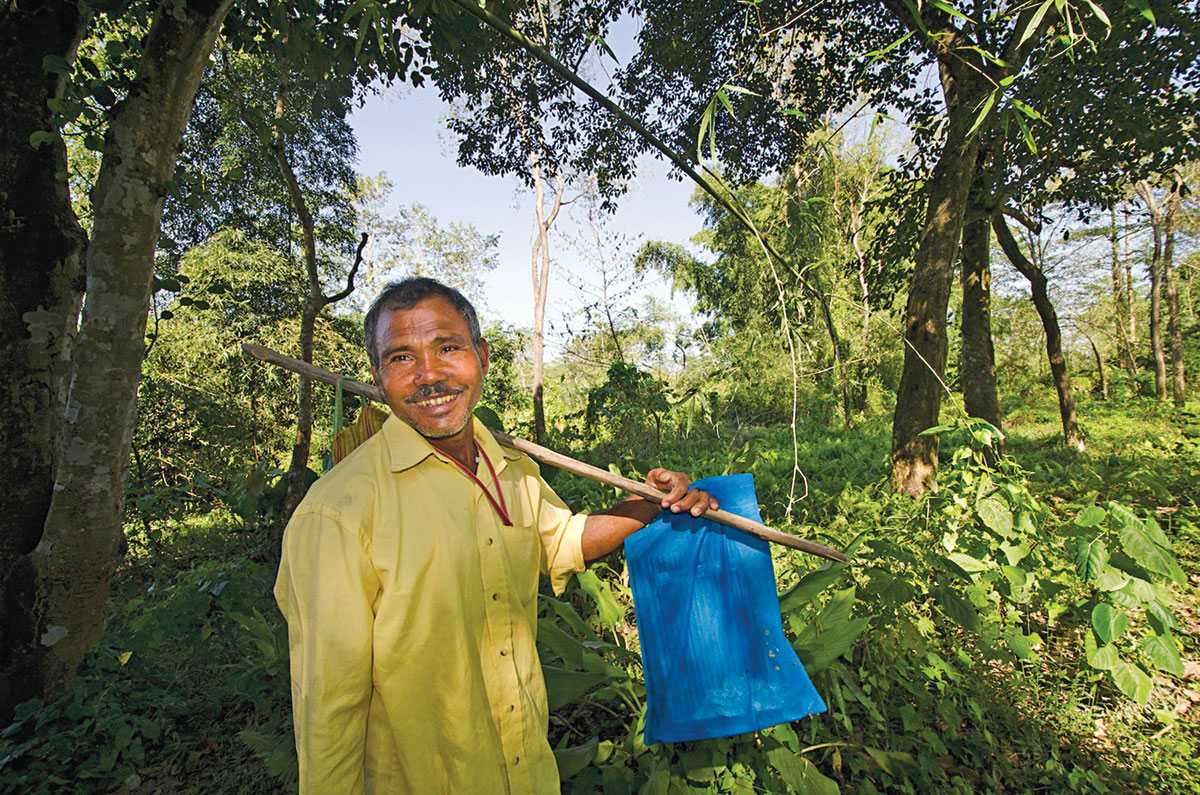 Sanctuary Wildlife Service Award winner Jadav Payeng from Majuli, an island in the Brahmaputra river, is from the indigenous Mising tribe of Assam. He has dedicated his whole life to planting and nurturing selectively chosen local tree species, then waiting for nature to turn the area into a wild forest. Photo Courtesy: Sanctuary Photo Library.
Jadav Payeng: The Forest Man of India
Sanctuary Wildlife Service Award winner Jadav Payeng from Majuli, an island in the Brahmaputra river, is from the indigenous Mising tribe of Assam. He has dedicated his whole life to planting and nurturing selectively chosen local tree species, then waiting for nature to turn the area into a wild forest. Photo Courtesy: Sanctuary Photo Library.
Jadav Payeng: The Forest Man of India
How Jadav Payeng turned a 1,300 acre stretch of desertified land near his home in Assam along the Brahmaputra river, into a forest, is a true hero’s journey, a tale for the rewilding canon! A deep love for animals and a visceral understanding of nature led him to start planting saplings in 1979. Not random planting, but carefully choosing what to play, and where to plant. And he took his cue by studying ants and other creatures large and small. The seeds they carried, he collected. When tiny sprouts grew from their droppings, he protected them. He did this every day for 30 years, all by himself. As the forest flourished under his loving care, locals began to call this safe haven for wildlife ‘Molai’, after a nickname given to Jadav as a child. After his hard work was discovered by a journalist in 2007, support for Payeng’s work began to pour in from far and wide. Former President Dr. Abdul Kalam officially gave him the title ‘The Forest Man’ on World Earth Day in 2010.
Today, Molai forest draws a large number of migratory bird species and is home to deer, elephants, rhinos, tigers, numerous reptiles and hundreds of birds. A Padma Shri awardee, Jadav credits only the power of nature for achieving this wondrous feat. He has travelled around the country and the world with the message that each of us can do the same as he did. All it takes is patience, persistence and a true understanding of the priceless gifts that only nature can impart.
Jadav’s patient nurturing of a degraded land into a thriving forest reminds us that we don’t need to acquire huge tracts of land or have degrees in environmental science to become restorers and rewilders of our land. In 2020, he signed an agreement with the NGO Fundacion Azteca to work as a collaborator on initiatives in Mexico, which endeavour to plant seven million trees in the country. “I’ll plant till my last breath,” Payeng has been quoted as saying.
Fringe Ford, Kerala
For over 110 years, the Fringe Ford area has been a logging concession and plantation. It is located in a horseshoe valley that has some of the headwaters that flow into the Kabini river – one of the only tributaries that originates in Wayanad and flows east and drains into the Bay of Bengal. It’s a 527 acre parcel of land, and this year the team has added 45 more acres of the neighbouring tea estate, making a grand total of 572 acres.
The enormity, biodiversity, and the sheer remote wilderness was the primary draw for conservationist Ahmed Chamanwala to set up an ecotourism venture there 16 years ago. Today, they have dedicated 90 per cent of the land to conservation, supported entirely by profits made from their five-room wildlife lodge.
When Ahmed first arrived on the land, poaching, tree felling, illicit liquor manufacturing, and growing of narcotic substances was rampant in the forest. The estate was a conduit and a safe buffer for these gangs to operate in the impenetrable wilderness. Fringe Ford was born as a response to this, with the team’s main commitment being to contribute to conserving the landscape. Ever since their wildlife lodge was set up, these destructive activities have completely stopped within the estate and surrounding forests.
Being surrounded by the Aralam Wildlife Sanctuary (which is a notified tiger reserve) and Wayanad Tiger reserve, an abundance of wildlife uses Fringe Ford as a corridor and safe haven. The decline in plantation activities over the years has positively affected the security and safety of these creatures. In the initial years, conflict with poachers, tree felling, and illicit liquor manufacturing mafia were the team’s biggest hurdles; threats to the team members’ lives and damage to property was the norm. But they stood their ground, and steadily built a relationship of trust and communication with the local Forest Department, which, over time, has made a positive impact for the flora and fauna.
As Ahmed puts it, these lands are the last frontiers in their battle against the wave of development that engulfs every part of India. He says that population pressures can only be deflected with initiatives such as Fringe Ford, which lie at the intersection of conservation and sustainable development. He opines that private land participation in conservation of forests is the only answer for a burgeoning India.
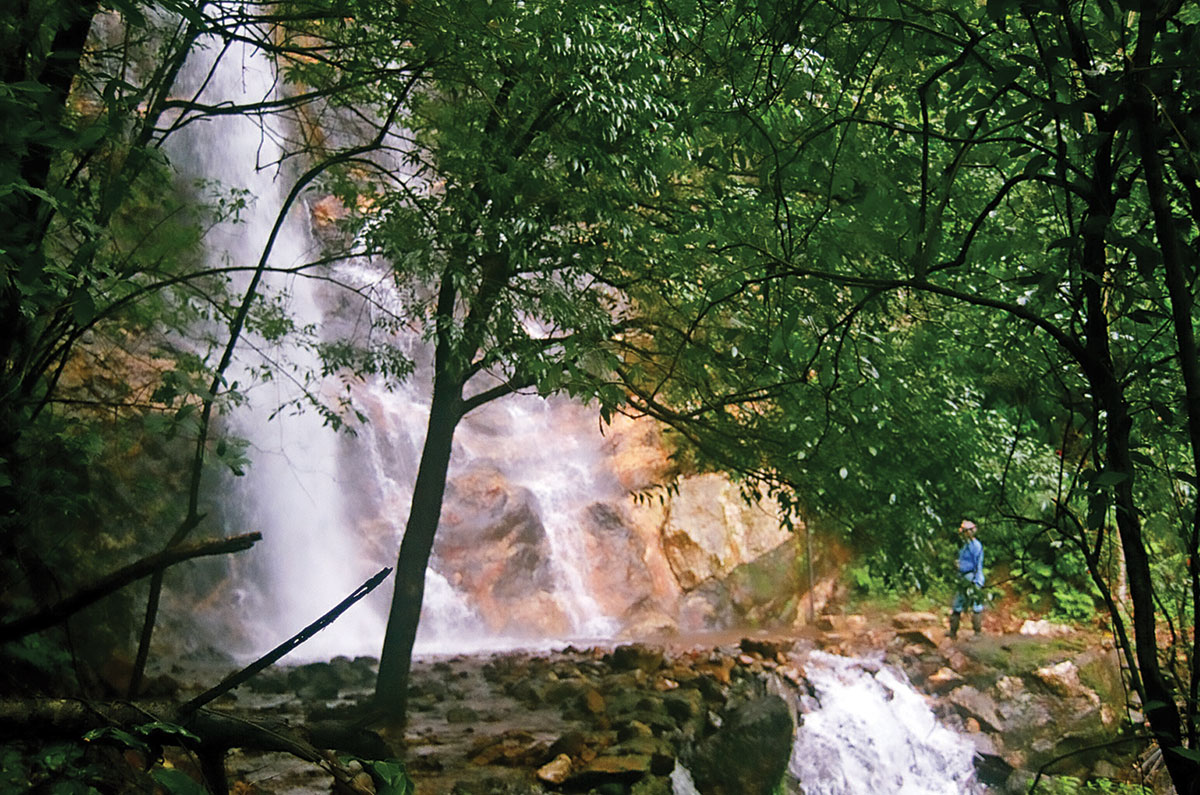
It was the enormity, biodiversity and the sheer remote wilderness of the land that drew Ahmed Chamanwala to the property that is now Fringe Ford. Located in a horseshoe valley that has some of the headwaters that flow into the Kabini river, the conservation of over 90 per cent of the land is being supported by a five-room wildlife lodge. Photo Courtesy: Fringe Ford.
Fringe Ford has a well-trained staff that hail from nearby villages, who take guests for guided wilderness walks within the boundaries of Fringe Ford, that cover all vulnerable areas of the restored forest.
The contribution by visitors patronising Fringe Ford for biodiversity is immense. There are 27 streams that originate in the valley and no soil runoff as the forest is healthy. With the plantation activity not operational, the use of any fertilisers or pesticides has been eliminated. Wildlife is at ease here; there are no fences, trenches or walls that interfere with their movements.
Being in a valley in India where you are cut off from the familiar sensoryscape of human habitation, the experience of not hearing any synthetic sound and artificial lights is priceless! The only two activities they offer are a sitting safari or walking safari (a sitting safari is when the wildlife comes to you around the bungalow). These non-motor centric activities have the lowest carbon footprint.
In the future, Ahmed and his team aim to continue keeping their footprint at below 0.5 per cent of the landscape they are in. They plan to add three more rooms to their property, and hopefully, will add more land under conservation. Ahmed also wants Fringe Ford to be a base for Technology in Conservation – tying in his work as Executive Director of Forest Conservation (India) with Grene Robotics – and support low impact tech that can be used in various conservation landscapes.
These visionary conservation stories leave us with a few common takeaways: one, that conservation can become economically viable when built into the founding principles of any business model. Two, that to meet the ambitious but urgent goals of restoring degraded lands, rewilding must become an attractive alternative livelihood option for local communities. Three, the rationale behind rewilding is bolstered by a multitude of stakeholder interests with shared goals and values. And finally, that a successful rewilding project seems to always be rooted in specificity: specific relationships between ecosystem and biodiversity; between land, water and people; and between each of us and the journey of ‘meaning-making’ we undertake when we begin to discover that to be a visitor, steward or member of the wild are one and the same thing.










